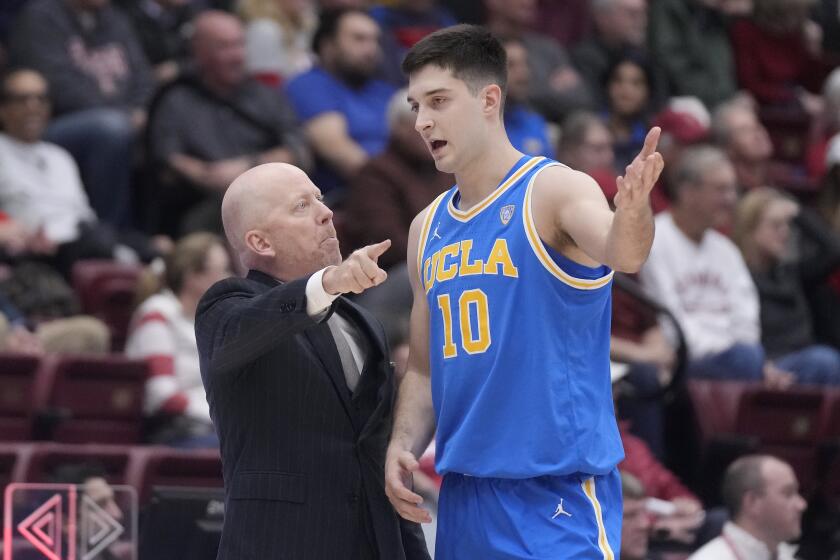Jim Eisenreich Taking It One Sweet Day at a Time in Return to Majors
The guy in Toronto had leaned over the railing and screamed, “Hey, are you nervous now?” Jim Eisenreich had to laugh at that.
He’d been sent up to pinch-hit during a close game against Toronto, and now this fan was yelling what fans before him had yelled in places like Minneapolis, Memphis and Charlotte.
Eisenreich said such comments once filled him with rage, because he himself didn’t know why the nervous tics and twitches began, only that he couldn’t stop them, and that three times they had halted a genuinely promising baseball career.
Nerves, though, had nerves been a problem?
“That’s what people always think,” he said. “They think I’m this uptight guy who can’t handle pressure. I’ll bet if you ask the (Minnesota) Twins right now, they’d still say that. No one wants to believe that it could be something else.
“When people get to know me, they realize what I’m like. I’m laid-back. If I strike out, the last thing I’m going to do is go in and tear up the clubhouse.”
Eisenreich is 28 now and back in the major leagues with the Kansas City Royals. If he stays this time--and he says, “I take it one day at a time”--he’ll be one of his sport’s most remarkable stories.
Once he was the kid who couldn’t fail. He’s a sports legend in his hometown, St. Cloud, Minn., and when he made a quick tour of the minors in the early ‘80s (206 games), he was compared to everyone from Fred Lynn to George Brett.
He was young and strong, a defensive flier in center field and the owner of a sweet left-handed swing. He was handsome, friendly and liked by almost everyone who knew him. He was going to be a star.
“I don’t like saying the game came easy,” he said, “but that’s probably true. If it had come a little harder, I might have had better work habits, and that caused me some problems down the line.”
What caused him more problems was something eventually diagnosed as Tourette syndrome, a neurological disorder that causes uncontrollable and sometimes violent tics, or muscle spasms.
Eisenreich had dealt with these spasms for as long as he can recall, but until 1982, they never kept him from participating in sports. That was the year he jumped from Class A Wisconsin Rapids to the big leagues, winning the Twins’ center field job in spring training.
He kept it for only 34 games and was forced to go on the disabled list when the twitches got so severe he couldn’t play. He tried to come back in 1983 but played just two games before walking away again.
He tried once more, appearing in 12 games in 1984, and when the twitches reappeared, he told the Twins he was retiring.
What bothers him is not that he had to give up organized baseball, but that so many people assumed his problem was psychological and not physiological.
A former teammate with the Twins agrees with this, saying, “Players walked on eggshells around him. They were afraid to do something that would set him off.”
In truth, he is just the opposite of nervous or uptight. He’s an extremely shy Minnesota farm boy with dark, burning eyes and a quick smile. His friends say that one reason Eisenreich may have been misunderstood is that he has always been something of a loner.
“I’ve known him since he was 6,” said Jay Johnson, a lifelong friend, “and if you wanted to do something with Jim, you called him. He wouldn’t be the one to call you.”
He drives a pickup truck, his wardrobe leans to jeans and flannel shirts and he says he’s never quite so happy as when he’s walking the backwoods of northern Minnesota hunting wild game. Son of a science teacher at St. Cloud State Reformatory, he spends much of his off-season hunting outside his town of 50,000 near Minneapolis.
When his return to baseball was finally complete this year, when he was burning up the Class AA Southern League, his one request to his family was, “Please bring my pickup down to Memphis.”
No clubhouse lawyer or funny man, he spends many of his pre-game hours alone in front of his locker.
When the Jim Eisenreich story is written, he says he wants the facts straight about his 1984 retirement. Three years removed from the last time he quit, he says he never once considered giving up the game: “Never. It’s all I’ve ever done. It’s what I love.”
Each time he left the Twins, his routine was the same: Return to St. Cloud, catch on with the semi-pro Saints and start planning his return. He worked briefly in an archery shop and once tried college “but was never interested.”
Instead, what he loved to do was play baseball and said he never lost confidence that he’d make it back.
“I don’t know that we ever felt sorry for him,” said Johnson, a St. Cloud bartender who manages the Saints. “I think a lot of us were even still envious because Jim had gotten the chance. He lived a dream for all of us. But, yes, we knew he belonged in a league other than ours. The guy was hitting .550 or something. We all saw the talent.”
But almost no one else did, and for a couple of years, it looked as if he would be one of the game’s huge disappointments and not one of its big stars.
In 1985, Eisenreich says, his life actually turned when the Twins sent him to a Minneapolis specialist, Dr. F.S. Abuzzahab, who diagnosed him as having Tourette syndrome. He was told medication probably could control the tics. He was overjoyed.
Eisenreich said, though, that once he had a diagnosis, “It was just a matter of getting the medicine (Haldol) adjusted. It was a trial-and-error thing with finding what would work and how much I was supposed to take. I don’t think the Twins understood that even after you had a diagnosis, it takes a while to get the medicine corrected.”
He says he has gotten letters from a lot of people, who tell them the same thing he heard for years.
“They say, ‘My doctor told me I was hyperactive,’ ” he said. “I heard that a few hundred times myself. Doctors just don’t recognize it, and I guess when you do get a diagnosis, you’re lucky. But you don’t beat it or cure it. You just try to live with it.”
The Twins had asked him about coming back for the springs of ’85 and ‘86, but Eisenreich said they never followed up on their conversations. But in 1986 after he asked to be taken off the voluntarily retired list, the Twins, under new management, shifted his name to the waiver wire. He had gotten three chances, and with this team, he wasn’t going to get another.
“I don’t think the Twins were ever serious about bringing me back,” he said. “The problem was that after they released me I didn’t know what to do. I was getting kind of worried because no one offered me anything.”
That’s when he got a break. Bob Hegman, a former teammate at St. Cloud State, had gone to work in the Royals’ farm department and knew Eisenreich was looking for work. He went to the Royals and convinced them Eisenreich was worth the gamble.
“I knew he had stayed in shape, kept his skills up,” Hegman said. “Teams are always looking for hitters, and this guy is a pure hitter.”
The Royals signed Jim, and his little brother Charlie, who had been an NAIA star at St. Cloud State.
Charlie is “doing pretty well, but he’s old (23) for the rookie league he’s in,” Jim Eisenreich said. “I feel badly for him because he should have had a chance before now. I think teams laid off him because he was my brother, and they assumed he’d have the same problem I’d had.”
In mid-February, Eisenreich showed up at the Royals’ camp in Fort Myers, Fla., and in about two days, the Royals knew they had something special.
“He looked even better than before,” said Royals Manager Billy Gardner, who when with the Twins had first brought Eisenreich to the big leagues. “He looked so much more relaxed, and he’d worked to keep his skills up.”
It wasn’t the easiest time for Eisenreich, though: “I knew everyone was watching me. I tried not to let it bother me, but I got the feeling that no one really expected me to be around very long.”
Instead, he passed every test. He hadn’t lost his swing, and he still had outstanding speed, especially between home and first. His only setback was near the end of spring training when he injured his elbow.
With Bo Jackson and Kevin Seitzer making the Royals, Eisenreich was one too many newcomers and was sent to Memphis. He said he believed the Royals probably also wanted to see how the medication and his swing held up before bringing him to the big leagues.
They found that everything held together perfectly. He tore up Southern League pitching, hitting .382 with 36 doubles, 10 triples, 11 home runs and 57 RBI.
He was called up to the big leagues a month ago and has continued to hit. His batting average is only .244 after 45 at-bats, but he has three homers and 12 RBI (one every 3.8 at-bats).
“The problem has never been in getting to the big leagues,” he said cautiously. “The problem has been in staying. Right now, I’m just trying to do my job and learn the pitchers again. But I love it here and feel comfortable. This is what I want to do.”
Others seem as happy for him as he is for himself. When he played his first game at Royals Stadium, Johnson and several St. Cloud players showed up wearing “Jim Eisenreich Comeback Club” T-shirts. The Tourette Syndrome Foundation has asked him about serving as a national spokesman. The Royals say he’s their regular designated hitter against right-handed pitching.
“I feel like I was in the right place at the right time,” he said. “After all this time, that may sound funny, but that’s how I feel.”
More to Read
Go beyond the scoreboard
Get the latest on L.A.'s teams in the daily Sports Report newsletter.
You may occasionally receive promotional content from the Los Angeles Times.










